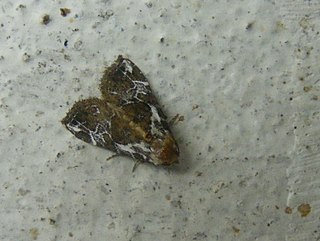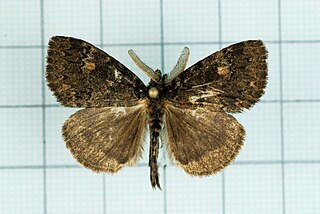
Attacus atlas, the Atlas moth, is a large saturniid moth endemic to the forests of Asia. The species was first described by Carl Linnaeus in his 1758 10th edition of Systema Naturae.

The Pyraloidea are a moth superfamily containing about 16,000 described species worldwide, and probably at least as many more remain to be described. They are generally fairly small moths, and as such, they have been traditionally associated with the paraphyletic Microlepidoptera.

The Limacodidae or Eucleidae are a family of moths in the superfamily Zygaenoidea or the Cossoidea; the placement is in dispute. They are often called slug moths because their caterpillars bear a distinct resemblance to slugs. They are also called cup moths because of the shape of their cocoons.

Lyclene is a genus of lichen moths of the family Erebidae, subfamily Arctiinae. The genus was erected by Frederic Moore in 1860.

Ptochostola is a genus of moths of the family Crambidae.
Aethalina is a monotypic moth genus in the family Erebidae. Its only species, Aethalina asaphes, is found in Queensland, Australia. Both the genus and species were first described by Turner in 1902.

Anuga is a genus of moths of the family Euteliidae. The genus was erected by Achille Guenée in 1852.
Labanda is a genus of moths of the family Nolidae erected by Francis Walker in 1859.
Batracharta is a genus of moths of the family Erebidae. The genus was erected by Francis Walker in 1862.

Chorsia is a genus of moths of the family Erebidae. The genus was erected by Francis Walker in 1863.
Hypenagonia is a genus of moths of the family Erebidae first described by George Hampson in 1893. The adult moths have pale brown wings with a dark band across each wing. The wingspan of these moths is about 1 centimeter.

Oglasa is a genus of moths in the family Erebidae. The genus was erected by Francis Walker in 1859.

Ilema is a genus of tussock moths in the family Erebidae. The genus was described by Walker in 1855 and renamed by Moore in 1860, because Walker's chosen name was preoccupied.

Ozola is a genus of moths in the family Geometridae first described by Francis Walker in 1861.

The Erebinae are a subfamily of moths in the family Erebidae erected by William Elford Leach in 1815. Erebine moths are found on all continents except Antarctica, but reach their greatest diversity in the tropics. While the exact number of species belonging to the Erebinae is not known, the subfamily is estimated to include around 10,000 species. Some well-known Erebinae include underwing moths (Catocala) and witch moths (Thermesiini). Many of the species in the subfamily have medium to large wingspans, up to nearly 30 cm in the white witch moth, which has the widest wingspan of all Lepidoptera. Erebine caterpillars feed on a broad range of plants; many species feed on grasses and legumes, and a few are pests of castor bean, sugarcane, rice, as well as pistachios and blackberries.
Anopina asaphes is a moth of the family Tortricidae. It is found in Guerrero, Mexico.

Didiguides is a monotypic moth genus of the family Nolidae erected by Lutz W. R. Kobes in 1994. Its only species, Didiguides semifervens, was first described by Francis Walker in 1863. It is found on Borneo, Sumatra and Sulawesi, as well as in New Guinea and on the Bismarck Islands. The habitat consists of dipterocarp forests, including alluvial forests.
Ptochostola asaphes is a moth in the family Crambidae. It was described by Turner in 1937. It is found in northern Australia.

Agriophara is a genus of moths in the subfamily Stenomatinae. The genus was erected by Rudolph Rosenstock in 1885.
Agriophara asaphes is a moth in the family Depressariidae. It was described by Alexey Diakonoff in 1948. It is found in New Guinea.












